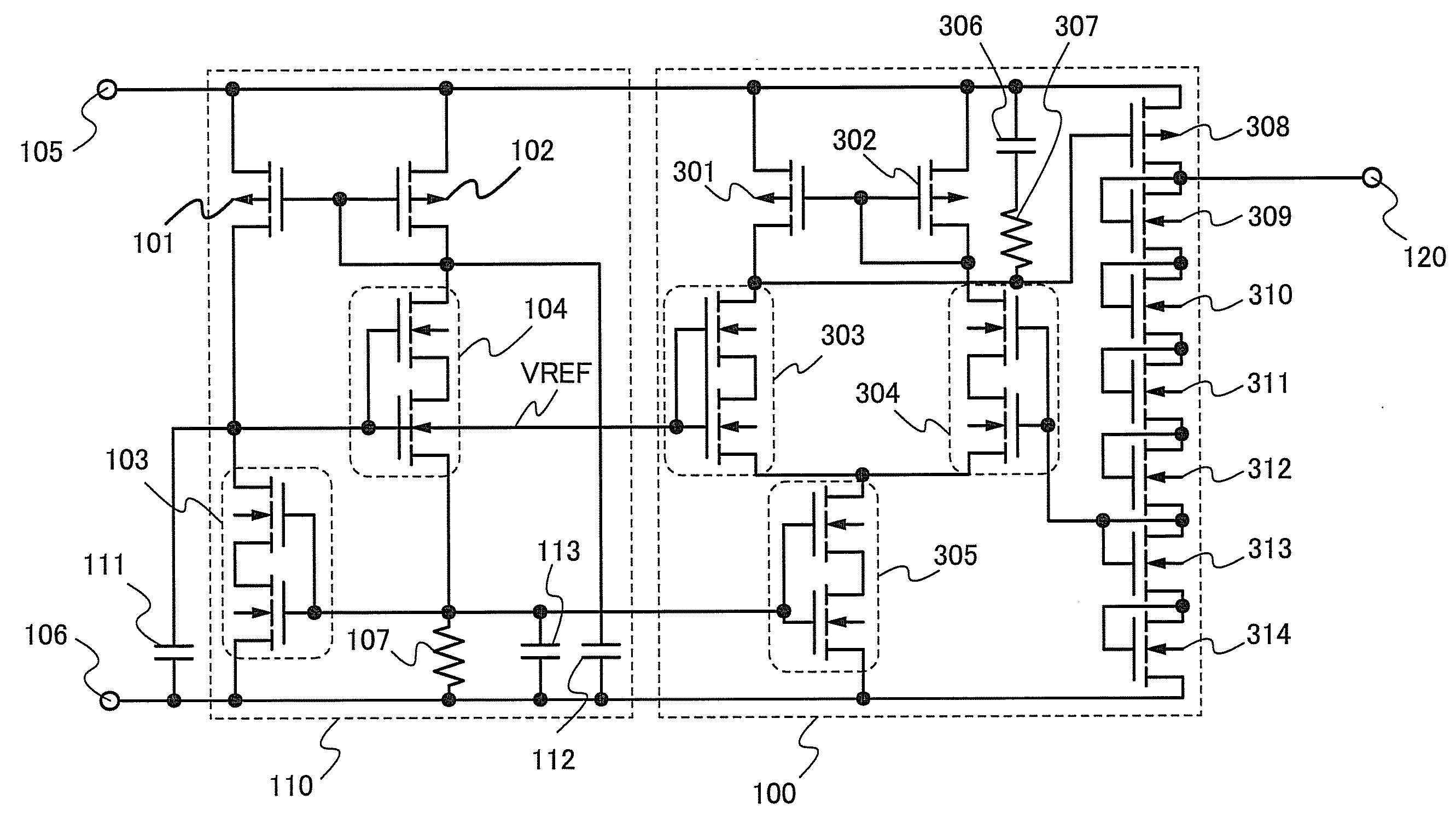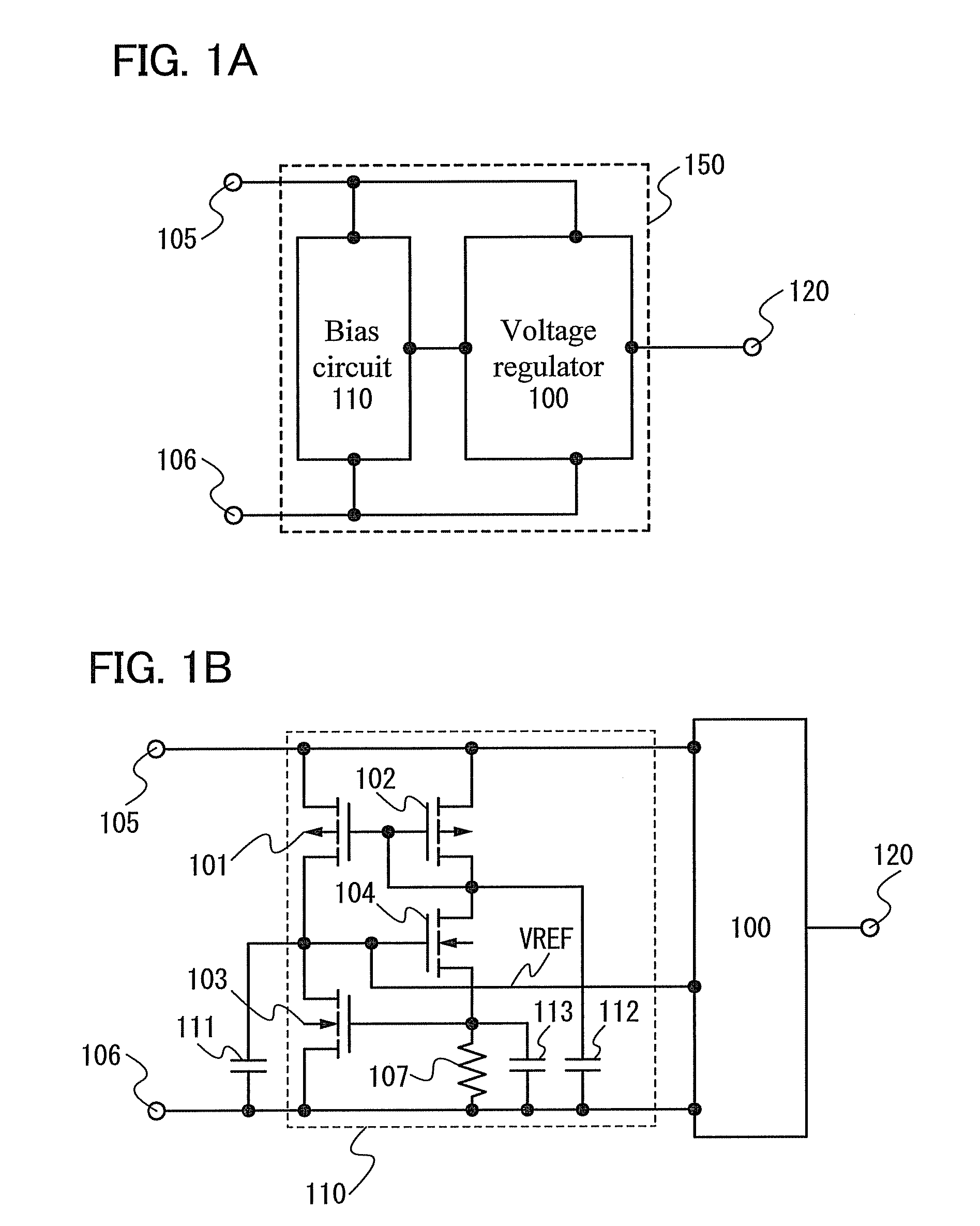Regulator Circuit and RFID Tag Including the Same
a technology of rfid tag and rfid circuit, which is applied in the direction of electric variable regulation, process and machine control, instruments, etc., can solve the problems of affecting the operation of the circuit, malfunctioning other circuits in the rfid tag, and extremely sensitive circuits to high-frequency noise from the outside, so as to improve the noise margin improve the reliability of the rfid tag, and improve the noise margin
- Summary
- Abstract
- Description
- Claims
- Application Information
AI Technical Summary
Benefits of technology
Problems solved by technology
Method used
Image
Examples
embodiment 1
[0033]An example of a configuration of a regulator circuit in this embodiment will be described with reference to FIGS. 1A and 1B.
[0034]As illustrated in FIG. 1A, a regulator circuit 150 disclosed in this embodiment includes a voltage regulator 100 and a bias circuit 110.
[0035]A reference power supply terminal 106 is a terminal to which a potential as a reference of a power supply voltage applied to the circuit illustrated in FIG. 1A is applied. In general, 0 V is applied to the reference power supply terminal 106, though other voltages may also be applied thereto because the potential applied to the reference power supply terminal 106 is only a reference of the power supply voltage of the circuit.
[0036]To an input power supply terminal 105, a potential obtained by using the potential of the reference power supply terminal 106 as a reference is applied.
[0037]The bias circuit 110 generates a potential VREF as a reference potential of the voltage regulator 100 in accordance with a vol...
embodiment 2
[0059]An RFID tag usually operates without a power supply directly connected thereto because of its application mode. In such a case, some terminals connected to circuits in the RFID tag cannot be grounded, which makes it difficult to take countermeasures against static electricity by utilizing grounding. In this embodiment, an example of countermeasures against static electricity in an RFID tag will be shown.
[0060]FIG. 2A is a top view of an RFID tag. A semiconductor integrated circuit 201 includes a regulator circuit and circuits having a function as an RFID tag, such as a rectifier circuit, a modulation circuit, a demodulation circuit, and other logic circuits. The semiconductor integrated circuit 201 is covered with a support 202. Furthermore, a shield 203 that is a thin film made of a conductive material is provided on the outside of the support, thereby protecting the elements included in the semiconductor integrated circuit 201 against electrostatic discharge.
[0061]FIG. 2B is...
embodiment 3
[0068]FIG. 3 illustrates an example of a configuration of the voltage regulator included in the regulator circuit shown in Embodiment 1. The bias circuit 110 has a configuration similar to that described in Embodiment 1. In FIG. 3, double-gate transistors are used as the transistor 103 and the transistor 104; however, single-gate transistors may be used as in Embodiment 1 or multi-gate transistors having three or more gates may also be used.
[0069]The voltage regulator 100 includes a differential amplifier circuit having transistors 301 to 305, a divider circuit having transistors 309 to 314, and an output control transistor that is a p-type transistor 308. The differential amplifier circuit includes a current mirror formed by the transistor 301 and the transistor 302, a differential pair formed by the transistor 303 and the transistor 304, and a current source formed by the transistor 305. A feedback circuit includes the p-type transistor 308 and the divider circuit formed by the n-...
PUM
 Login to View More
Login to View More Abstract
Description
Claims
Application Information
 Login to View More
Login to View More - R&D
- Intellectual Property
- Life Sciences
- Materials
- Tech Scout
- Unparalleled Data Quality
- Higher Quality Content
- 60% Fewer Hallucinations
Browse by: Latest US Patents, China's latest patents, Technical Efficacy Thesaurus, Application Domain, Technology Topic, Popular Technical Reports.
© 2025 PatSnap. All rights reserved.Legal|Privacy policy|Modern Slavery Act Transparency Statement|Sitemap|About US| Contact US: help@patsnap.com



